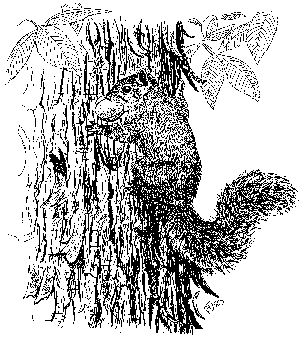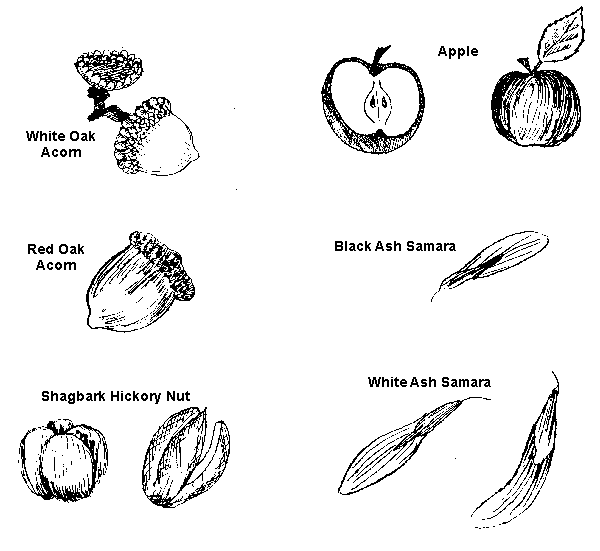Mast for Wildlife
Mast is the dry fruit from woody plants. Examples include samara from maple, elm and ash; various pine seeds; and nuts from oak, hickory, beech, witch hazel and black walnut. Mast is the primary fall and winter food for most forest wildlife species. In some areas, acorns may comprise more than 50 percent of the fall diets of white-tailed deer and wild turkey.
A combination of mast-producing trees and shrubs is more favorable in the event that one type fails to produce for one or more years. In Connecticut, oaks are the most valuable mast producer. White oaks produce a very palatable, sweet mast every year and red oaks produce a bitter mast crop every other year. White oak acorns, because of their palatability, generally do not last through the winter, while red oak acorns remain available, providing a food supply during critical periods of scarce food.
In a hardwood forest, a minimum of 15 oak trees, 14 inches diameter at breast height (dbh) or larger, will provide the necessary food source for mast dependent wildlife species such as deer, turkey and squirrels.
Hickory trees also produce nuts which are eaten by squirrels, turkeys and other wildlife. Beechnut, black walnut, butternut and hazelnut are used by wildlife too, but are either not reliable, consistent food producers or they are scattered and limited in quantity.
Management for Mast
Pole stands, with their tight crown canopies and sparse understories, are the least productive mast producers. These stands can be managed by group selection in order to open up the crown canopy and increase potential acorn production. This benefits wildlife by creating understory growth and encouraging the regeneration of oaks, maples, birches, hickories, cherries and other species.
Ideally, 48 percent of forest land should be in sawtimber size (12 inches dbh or greater) to maximize mast production. At suitable sites, mast trees with a dbh of 20 inches or more should be encouraged.
Glossary
Canopy -- the more or less continuous cover of branches and foliage formed collectively by the crowns of adjacent trees and other woody growth.
Diameter at breast height (dbh) -- the standard diameter measurement for standing trees, including bark, taken at four and one-half feet above ground.
Group selection -- an uneven-aged silvicultural system; trees are removed in small groups, here and there, from a large area each year; regeneration is mainly natural and the stand is ideally composed of many ages.
Pole tree -- a young tree (from five to 11 inches dbh), from the time its lower branches begin to die until the time the rate of crown growth begins to slow and crown expansion is noticeable.
Samara -- a winged, usually one-seeded fruit that does not split open.
Sawtimber trees (12 inches dbh or greater) fit to yield saw logs or logs that will yield sawn timber.
Understory herbaceous vegetation, shrubs and small trees growing under the canopy formed by taller trees.
 The Technical Assistance
Informational Series is 75 percent funded by Federal Aid to Wildlife Restoration -
Pittman-Robertson (P-R) Program. The P-R Program provides funding through an excise tax on
the sale of sporting firearms, ammunition, and archery equipment. The remaining 25 percent
of the funding is matched by the Connecticut Wildlife Division. (rev. 12/99)
The Technical Assistance
Informational Series is 75 percent funded by Federal Aid to Wildlife Restoration -
Pittman-Robertson (P-R) Program. The P-R Program provides funding through an excise tax on
the sale of sporting firearms, ammunition, and archery equipment. The remaining 25 percent
of the funding is matched by the Connecticut Wildlife Division. (rev. 12/99)

